Willem Bastiaan Tholen, a painter with a passion for skating
Author: Nelly Moerman
English translation: Cis van Heertum
You may have experienced this yourself; returning to a place after some years and finding things to be different, even though they seem the same. Something like this must have happened to Willem Bastiaan Tholen (1860-1931), who in 1891 painted the frozen pond in the Haagse Bos park. More than 25 years later, he painted the same frozen pond once again. If we compare the two paintings, it turns out there’s a world of difference between them.
How crowded it is!
The first painting (1891), which is part of the collection of the Kunstmuseum Den Haag, is a large canvas measuring 100 x 130 cm. (fig.1)The painting was on show in the exhibition Echte Winters (Real Winters) at Teylers Museum in Haarlem in the winter of 2015/2016. The first impression is that of an overwhelming number of people, painted in hues of brown and grey. When visitors to the museum come face to face with this impressive mass of people, they often call out in surprise: ‘How crowded it is!’.
 Schaatsenrijden in het Haagse Bos, 1891 olieopdoek 99,5x132,5cm hoge resolutie KLEIN.jpg?1490102617317)
Kunstmuseum Den Haag, 0331459
Alternating horizontal bands
How did Tholen manage to bring structure into this vast swirling mass? He did so by alternating light and dark horizontal bands. The lowest part of the painting lies in the shadow and is painted in dark hues. So dark in fact, that it is sometimes difficult to distinguish the figures. Above this dark band is a lighter one that has more colour and detail. A low set sun shines across the icy plane from the right. Further to the top, the background is formed by a dark band in which the figures no longer stand out individually but seem to dissolve into the crowd. The scene is bordered by a line of trees, fuzzily painted in a brownish pink hue. The shape of Huis Ten Bosch palace appears on the far right.
Painter friends
Tholen loved skating and created several ice scenes. For this painting he chose a high perspective to render the idea of a large expanse of ice. It also gave him the opportunity to include many details. Below left in the dark part he depicted his painter friends with their wives. In the left corner are Willem and Jacob Maris, the latter wearing a top hat. The bowler hat above belongs to Willem de Zwarte. The friends do not seem to be actively taking part in the fun on the ice, but are engrossed in each other. We, as viewers, are looking at the large expanse together with the two young women who pop out from the lower edge of the canvas wearing a white and a red hat. Their hats provide a colourful touch in the dark foreground. Tholen applied the red colour throughout the painting, always in small details.
Vivacious forms
It’s a vivacious scene that has a lot of movement. The ladies are wearing sweeping coats. The art of skating is depicted in various ways. There are solo skaters quietly gliding across the ice with their hands in their pockets. (fig.2) Above the lady wearing a red hat, a couple is skating holding a skating stick. To their right is a man with a cap, his arms folded across his chest. His pose is reminiscent of the etching by Rembrandt (1639), who portrayed his skater in a similar way two and a half centuries earlier. See article Rembrandt’s skating etchings and the development of visual tradition.
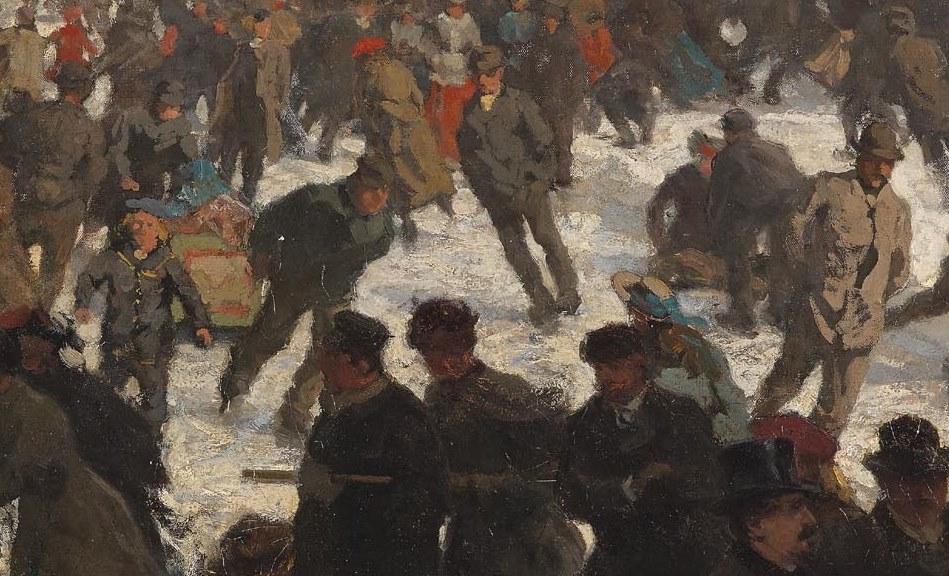
There is a lot more to be discovered in the painting. Above the earlier mentioned man with his arms in front of his chest, a woman is sitting on the ice. She must have just had a fall, as she is still leaning with her hand on the ice. A man has approached to help her and is leaning forwards. More to the left a woman is pushing a box sledge. It seems as if the man at the front of the sledge is with her and is making a great effort to pull the load.
Several types of skates
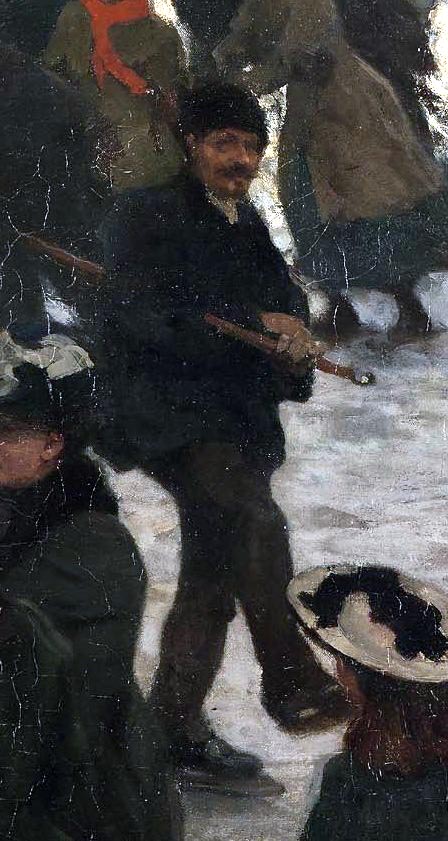
Tholen did not only lavish a great deal of attention on the various skating postures. He also depicted several types of skates. In the middle foreground in the dark part, a man is skating with a stick clutched under his arm like a field marshal’s baton. (fig.3) He is the only one whose gaze is directed outwards, and he is wearing iron figure skates. It may be concluded that they are made of iron from the white spot underneath his right foot, which indicates an opening in the iron skate. More to the right, a man wearing a light grey hat is standing with his hands on his back. (fig.4) His robust skates recall the so-called ‘Hollandse baanschaats’, a track skate. The couple depicted in the right of the painting are wearing altogether different skates. (fig.5) The man’s skates could be Frisian skates. His wife is wearing a more straightforward type with an iron blade with a front curve. On the left two boys are depicted, one of whom is kneeling down. (fig.6) A striking detail is the rather large size of their skates. (fig.7)
 Schaatsenrijden in het Haagse Bos, 1891 olieopdoek 99,5x132,5cm hoge resolutie KLEIN detail schaatsen rechts.jpg?1490643263525)
 Schaatsenrijden in het Haagse Bos, 1891 olieopdoek 99,5x132,5cm hoge resolutie KLEIN detail schaatsen links.jpg?1490643379129)
Averse to photography
Tholen meticulously prepared his work and made numerous preliminary sketches. He was not fussy in his choice of material to draw on and used anything that came to hand. At the time photography was an upcoming medium, but he wanted no part of it, whereas other painters, such as his contemporary Breitner, did make use of photographs. According to Tholen, painting and photography were two distinct processes that could not be reconciled. He felt photography had a negative impact on the creative process.
A quarter of a century later
Willem Bastiaan Tholen was around thirty when he was working on the large canvas. He must have been in his late fifties when he made the second painting, which is dated 1917. (fig.8) This latter painting is smaller, measuring 40 x 70 cm. It long remained in the family and is now part of the collection of the Centraal Museum in Utrecht. The composition of the scene is tranquil and harmonious and there is a marked narrowing of scope compared to the painting in The Hague. The dark foreground has also been omitted. The perspective is much lower and it seems like the painter has been standing on the ice. The lines in the scene lead to a central vanishing point on the horizon where Huis Ten Bosch palace can be seen through the bare trees.
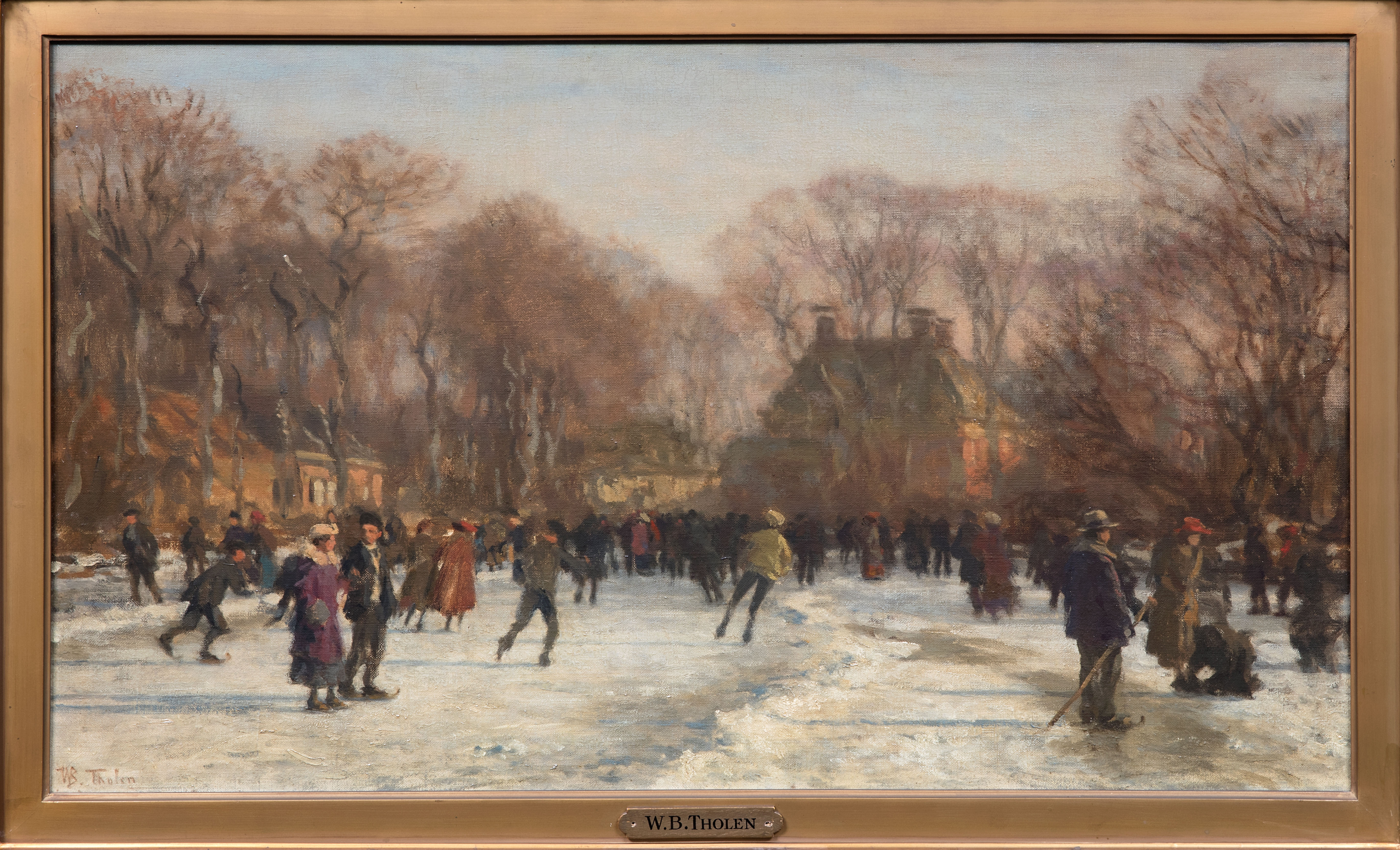
Centraal Museum Utrecht, 21844
Friends and relatives?
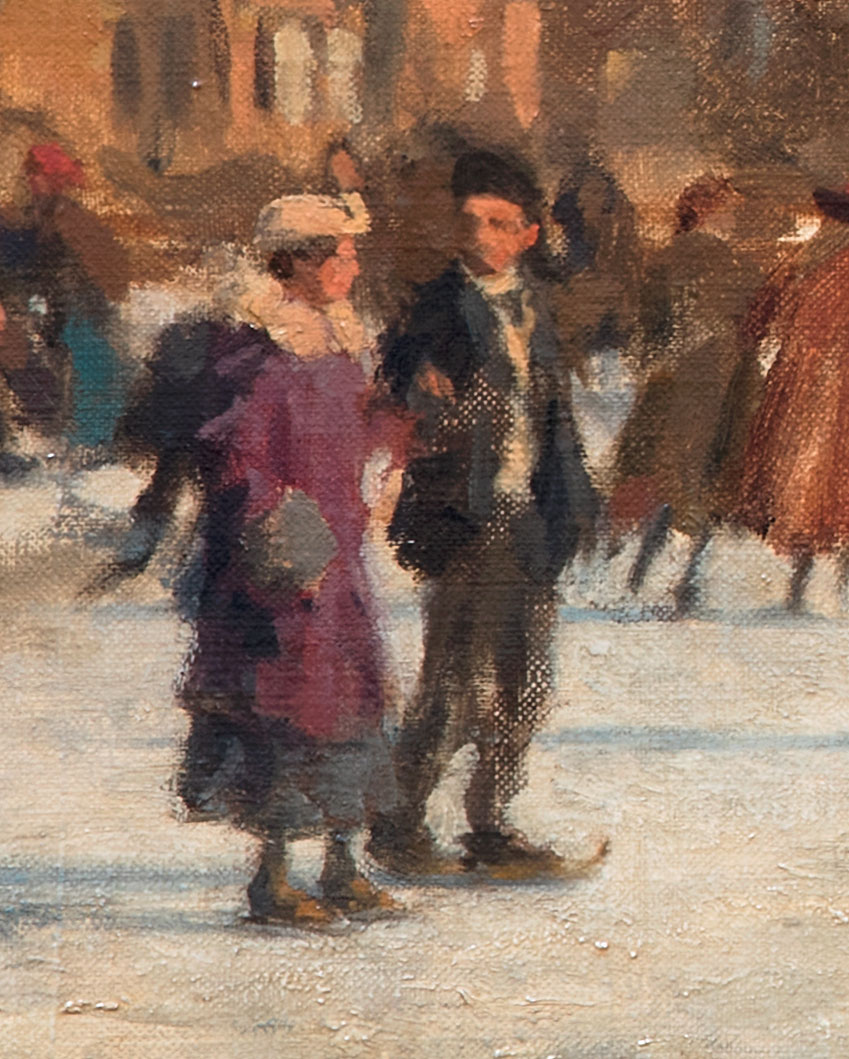
Almost all figures in this winter scene are painted from the back. One exception is the couple on the left, who are standing on their skates with their arms linked. (fig. 9) The woman especially cuts a striking figure. Her
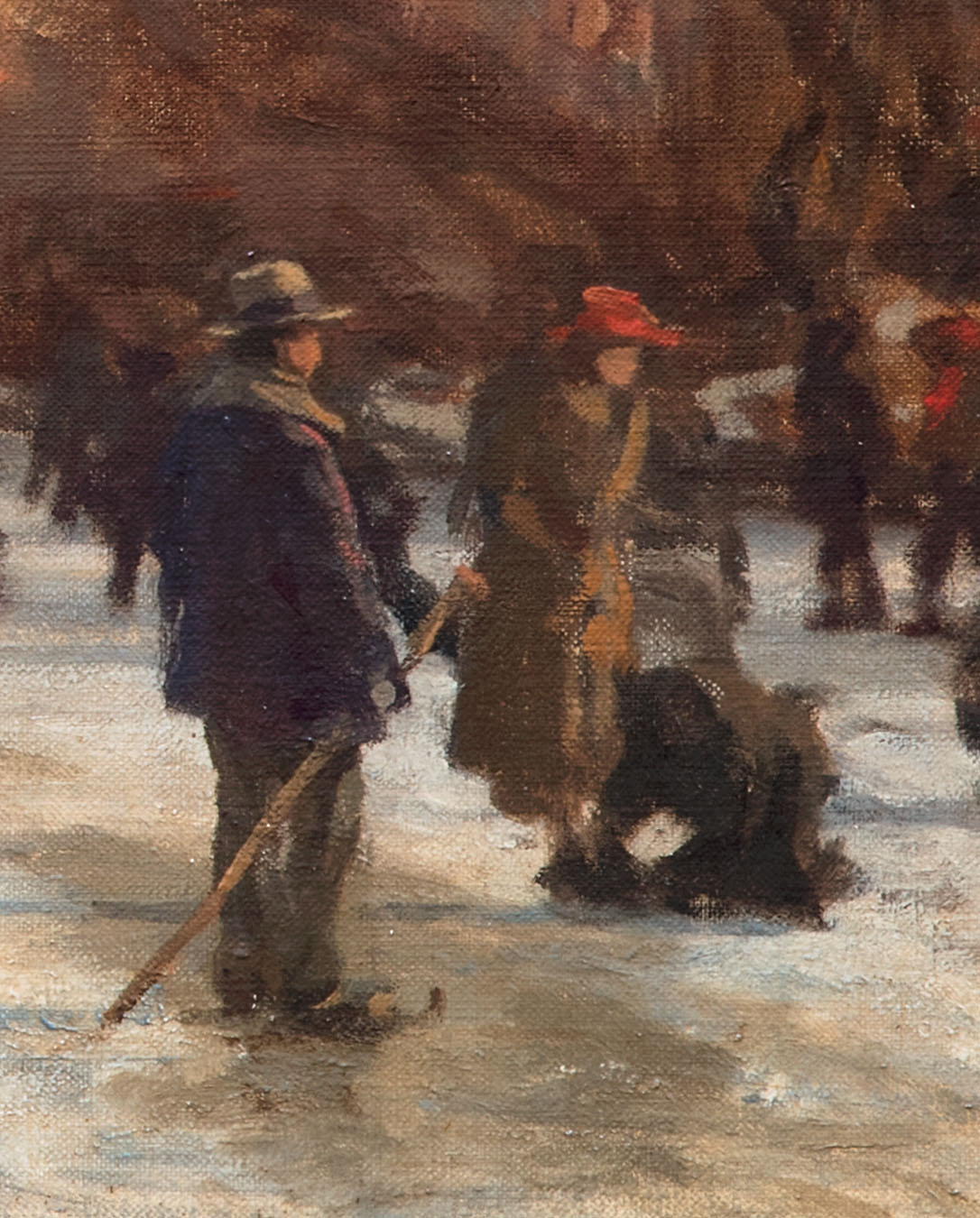
purple coat with its white fur collar and matching hat provide a nice touch of colour. The skater in his white jumper in the middle also catches the eye. He has the characteristic pose of a figure skater who has just pushed off. On the right a lady can be seen who is being assisted with her skates. (fig.10) Her red hat stands out well against the dark background. A man with a skating stick in his hand is waiting a little further away. No doubt the two of them will be skating away holding the stick.
Tholen had a habit of choosing people from his own circle as subjects for his paintings. In the large painting (1891) he depicted his painter friends. (fig.1) Around 1905 he painted a small panel (21 x 32 cm) featuring himself and a few relatives skating on a frozen waterway (Museum Gouda). (fig.11)
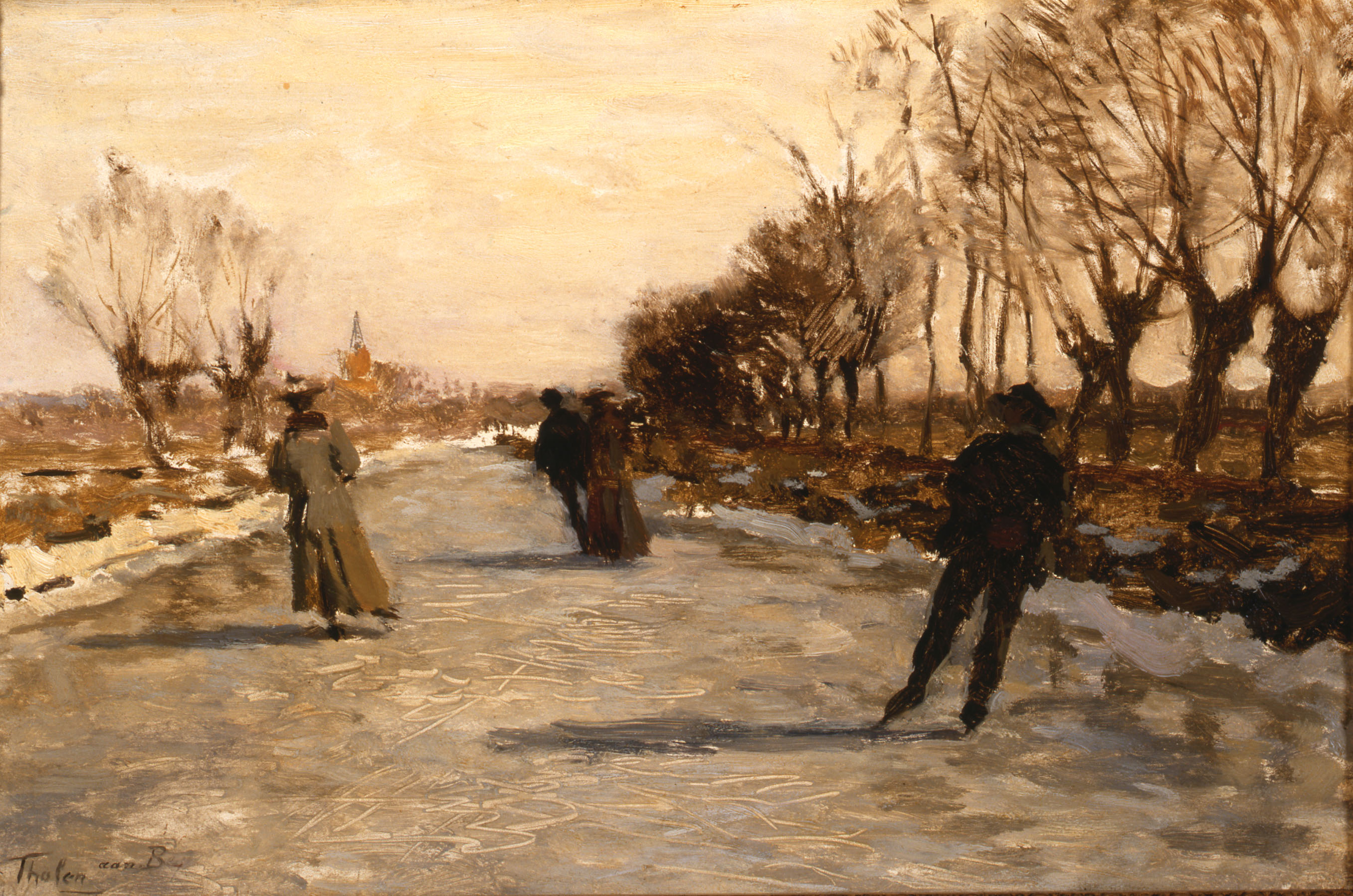
Collection Museum Gouda, 55432
In the Utrecht painting (1917), the couple on the left and the man and woman on the right have been portrayed with such detail, that here, too, Tholen may have depicted acquaintances of his. (fig.8) In one catalogue (1993, p.92), it is claimed, without explanation, that the figures were not friends or acquaintances. Is this really true, however?
Hidden meaning?
The painting marks an important stage in Tholen’s life. His first wife died in 1918 following a long illness and he remarried in 1919. The delicate rendering of the figures and the place they have been accorded in the painting are remarkable. From left to right they are a young couple, in the middle a man skating on his own, and on the right an older couple preparing to go skating together. It is conceivable that Tholen represented the various stages in his life in this painting. Apart from a possible hidden meaning, it is remarkable how persuasively the painting reflects the atmosphere of a fine winter’s day. The sun is low and the long shadows on the ice suggest it is late in the afternoon. The tumult and detail in the early painting of 1891 is gone. What abides here is serene calm.
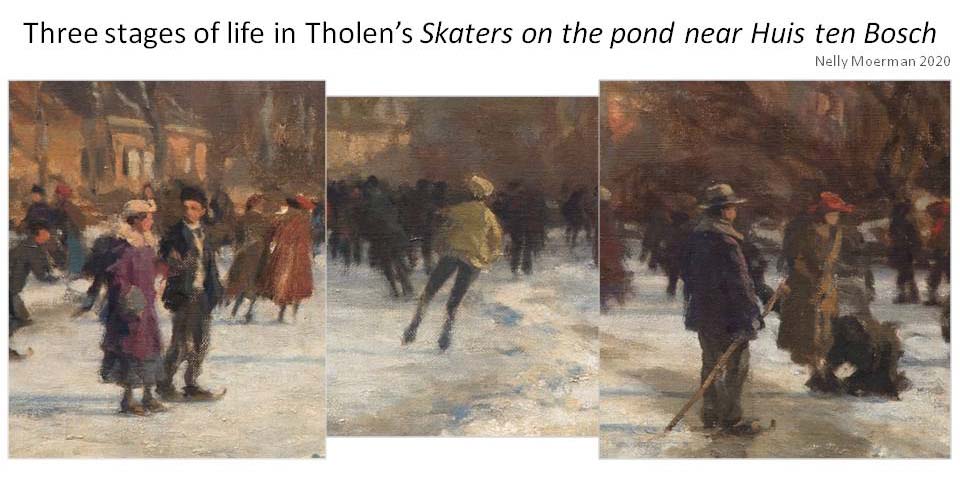
The love of skating endures
It is abundantly clear that Tholen managed to capture his love of skating to perfection in his winter scenes. When the two paintings from The Hague and Utrecht are put side by side, they show a difference in viewpoint that can be explained as the result of his artistic development. (fig.12+13) There is more to be said about these two paintings, however. There is more than a quarter of a century between them. Comparing the two scenes in any case confirms what every skating enthusiast is well aware of: time moves on, points of view may change, but the love of skating endures!

13. right: 1917, Centraal Museum Utrecht (40 x 70 cm)
References
1) Jong, Anneke de, Willem Bastiaan Tholen 1860-1931, exh. cat. Museum Het Catharina Gasthuis Gouda/ Drents Museum Assen, 1993.
2) Roosenboom, Hans, Myths and misconceptions: Photography and painting in the nineteenth century, Simiolus: kunsthistorisch tijdschrift vol. 32 (2006), issue 4, pp.291-313.
Source
This article is a revised version of an article published in Kouwe Drukte 2017; Year 21, No. 59, pp. 21-26.
The pond in the Haagse Bos park has been discussed by:
- Matthy van Klaveren in Kouwe Drukte 2016, Year 20, No. 56, pp. 26-28
- Niko Mulder in Kouwe Drukte 2017, Year 21, No. 59, p. 27
© Nelly Moerman 2020
This article is protected by copyright. Reproduction of the text, in whole or in part, is permitted only on an individual basis and under the conditions of acknowledgement of source and correct citation. In case of a financial interest or the pursuit of such an interest, copying is not allowed. In case of doubt, please contact the author, who can be reached through redactie@schaatshistorie.nl.